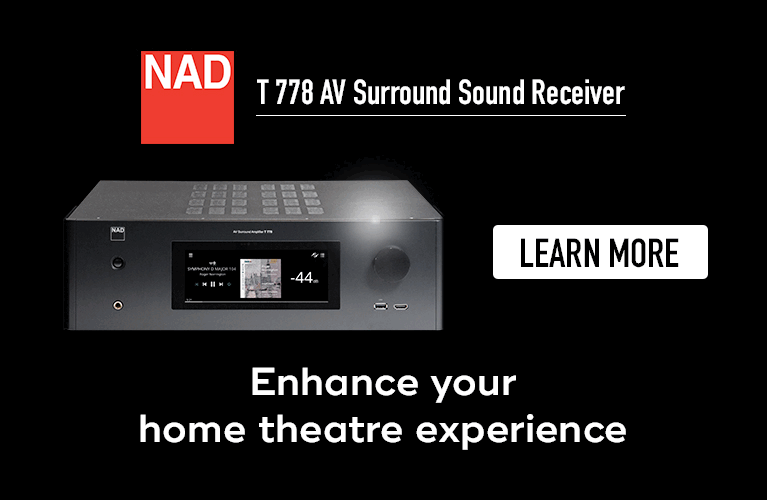Plenty has already been written about the awfulness of the high-end hi-fi section of the 2017 Consumer Electronics Show, including commentary in our own on-the-spot show coverage on SoundStage! Global, Ken Kessler’s “CES-Sux” article on this site this month, and in articles on other websites around the world. Timing and location weren’t to blame -- CES 2017 was held about the same time it always is, January 5-8, and its high-end hi-fi segment occupied the Venetian hotel, as it has for years. But all numbers were way down even from 2016, which itself had been a decline from previous years. Display rooms, exhibitors, attendees -- the totals of all of those paled in comparison to what they once were. The only things that were up were the Las Vegas prices for hotel rooms, food, you name it -- the costs were sky high. Which meant that everyone who attended paid a lot more for a lot less.
Yet despite CES 2017 being high-end hi-fi’s worst in decades -- maybe ever -- we made the best of it, and produced the best show coverage we could. In past years, by the end of the fourth and final day we’d usually run out of time and had missed many things; this year, by the end of the third day we were struggling to find more to report on. Still, that didn’t diminish the quality of what we did find, and especially the seven special products that have made the cut to be included in our list of the Best of CES 2017. (All prices in USD.)

YG Acoustics Sonja XV loudspeaker system
When I first looked at YG Acoustics’ Sonja XV loudspeaker system, I had serious concerns about how it would sound. It looked big and unwieldy, even with ample room to breathe in one of the Venetian’s very large rooms. Designed to commemorate YGA’s 15th anniversary and officially released last fall, the Sonja XV handles each stereo channel with two large, all-aluminum towers: one holds three woofers, the other a tweeter, two midranges, three lower-midranges, and one woofer. Total cost: $265,900. While some might be impressed by all those drivers and four huge cabinets, I wondered: Could the outputs of 20 drivers possibly be coherently combined? My concern was further exacerbated by the fact that, when I sat on a sofa a good 15’ away from the Sonjas, my ears were on the axis of the middle lower-midrange drivers -- the tweeters fired way above my head.
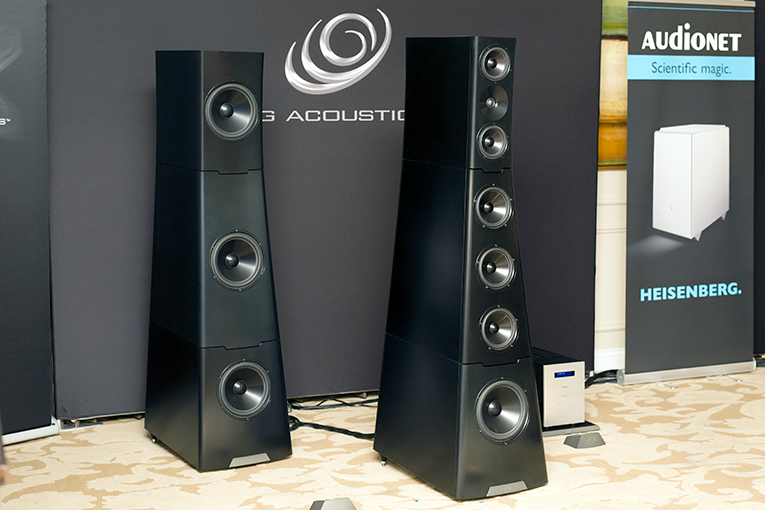
The proof was in the listening. Much to my surprise, the outputs of the Sonja XVs’ 20 drivers did blend exceptionally well. In fact, when I closed my eyes to focus only on the sound, had I not known there were four towers and 20 drivers before me, I would probably have thought the sound was originating from far fewer drivers placed much closer together. Overall, the sound was incredibly precise, extremely natural, and wickedly detailed. Not surprisingly, given all those woofers, the Sonjas could extend to 20Hz, the bottom of the audioband, with the utmost power and control. I listened over two days, each time with a different array of Audionet electronics YGA had hooked up, and at a different spot on the sofa. When I finally got to sit smack dab in the sofa’s center, I heard an expansive soundstage with outstanding image specificity and incredible depth. The Sonja XV was the biggest, most expensive speaker system I listened to at length at CES 2017. It was also the best sounding.
ELAC Adante AS-61 loudspeaker
Much smaller in size and cost was ELAC’s Adante AS-61 stand-mounted loudspeaker ($2500/pair), designed by Andrew Jones (shown below), who’s well known among audiophiles for his decades of designing speakers, first for KEF, then TAD, and now ELAC. But despite it being considerably smaller, cheaper, and lighter than the YGA behemoths, the three-way Adante AS-61 includes two interesting technical twists that should appeal to audiophiles who want great sound at an affordable price.
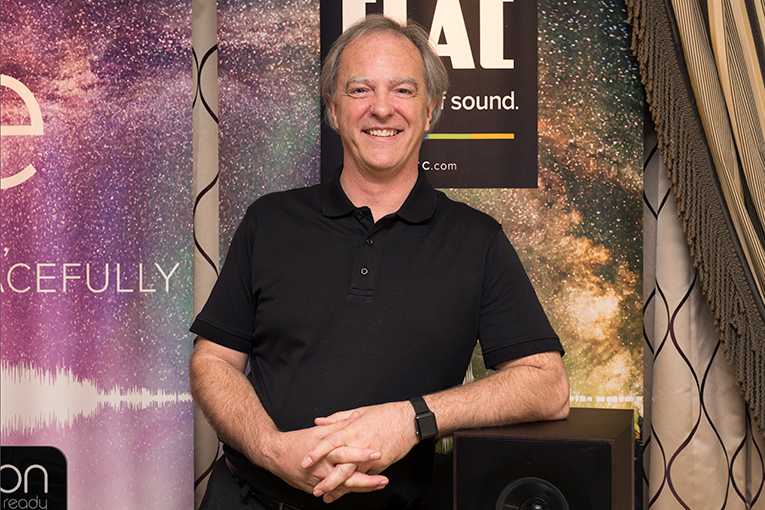
First are the AS-61’s coincident tweeter and midrange cone: the former is nested in the throat of the latter, so that their soundwaves are launched from the same point in space -- not a new or original configuration, but one that has become a hallmark of Jones’s work. Every speaker he designed for TAD had a coincident tweeter and midrange, and, while at KEF, Jones helped developed the Uni-Q coincident drivers on which all KEF speakers are now based.
Even more interesting is how the Adante AS-61’s bass section works. Viewed from the outside, the speaker looks as if it has just one woofer -- a front-mounted 8” cone. But that’s actually a passive radiator not driven by the amplifier. Instead, inside the speaker is a 6.5” woofer that is driven by the amp, and whose output passes through two internal chambers to energize the 8” radiator. ELAC might call it something else, but I’ve heard this sort of bass system called a coupled-cavity system, made famous by KEF in their 104/2 loudspeaker, launched in 1984 -- when Jones was working there.
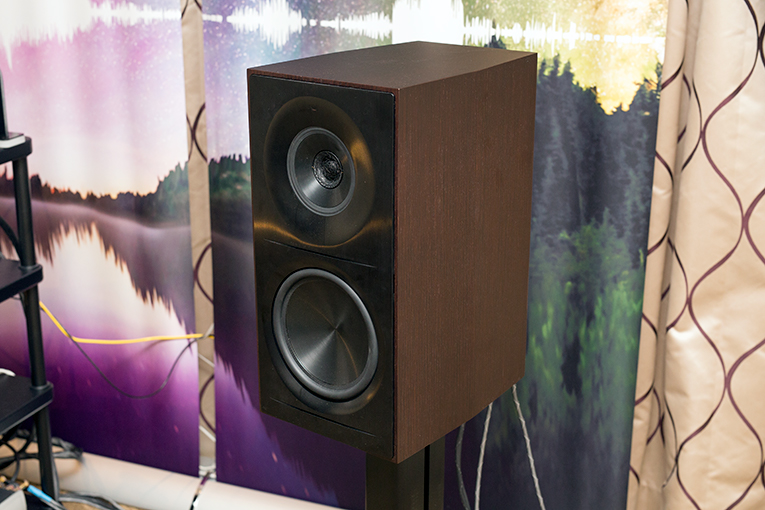
This revisiting of the coupled-cavity technology seemed to work very well -- the Adante AS-61 produced prodigious bass for its modest size, and, thanks to its excellent midrange-tweeter array, crystal-clear mids and highs. I’m sure many who saw the Adante AS-61 at CES didn’t realize that they were looking at a passive radiator driven by the output of a smaller, active woofer hidden inside. When I asked Jones why he wasn’t making more to-do about the way the AS-61’s active and passive woofers work, he told me that the strategy was deliberate -- he wanted people to hear what the speaker could do, regardless of how it did it. I can’t say I blame him -- for its price, the Adante AS-61’s sound quality was something special.
Totem Acoustic Signature One loudspeaker
For Totem Acoustic, it all began in 1987, when they began to develop their Model One, officially released in 1989. I well remember that speaker’s launch -- it generated a lot of buzz among audiophiles, who were generally impressed with how so small a two-way minimonitor, with only a 5” midrange-woofer and a 1” tweeter, could generate such a big, ballsy sound. In fact, the Model One’s success put Totem on a sure footing and helped make them the powerhouse speaker maker they are today. Counting only bookshelfs and floorstanders, Totem currently offers more than 16 models -- but they also make in-wall, on-wall, and in-ceiling speakers, as well as subwoofers.
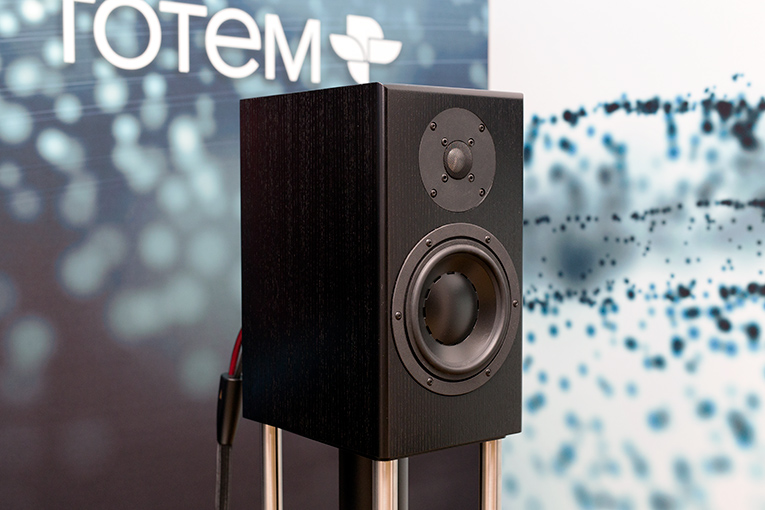
Yet at CES 2017, Totem showed that they haven’t forgotten where they came from. I smiled a big smile when I saw founder Vince Bruzzese demonstrate the new Signature One ($2595/pair), designed with the Model One in mind to commemorate Totem’s 30th anniversary -- and if you ask me, it’s a fitting model to celebrate with. Though it looks a lot like the original Model One, the Signature One is a completely new design that features a 1” aluminum-titanium-alloy dome tweeter and a 6.5” midrange-woofer with a 3” voice coil, the latter for high power handling and the big-speaker sound this model displayed at CES. This it provided in abundance when Bruzzese played the prototypes at CES 2017.
The one thing I didn’t ask Bruzzese when I was there was if he’d be personally signing each production unit of the new model -- after all, it’s called the Signature One, and it’s an anniversary edition likely to become a collector’s item. Having that personal touch would only increase its value. Let’s see what transpires come production time, which should be in a month, maybe two.
KEF LS50 Wireless loudspeaker
KEF was founded in 1961, more than a half-century before the launch of the original LS50 loudspeaker, which was designed to commemorate KEF’s 50th anniversary. Its wild success has made it one of the most popular speakers released in the last 20 years, and let the world know that, as a speaker maker, the legendary British firm is still on fire. From what KEF told me when I visited in 2015, they’d hoped to sell thousands of pairs of LS50s; instead, they’ve sold many tens of thousands, and sales are still going strong. Visit YouTube to watch our SoundStage! Shorts video about the LS50, featuring designer Mark Dodd. Mirroring the success of the speaker itself, so far it’s our most-watched Shorts episode.
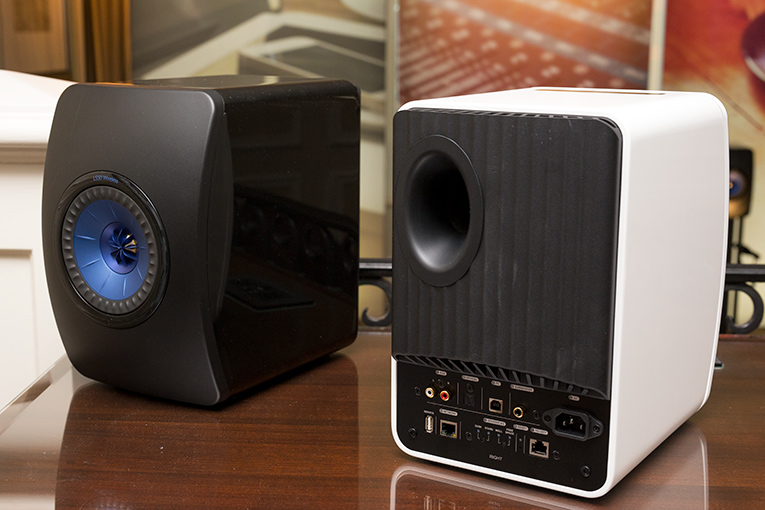
KEF has now released the LS50 Wireless. While it remains to be seen if the Wireless will be as successful as its predecessor, what KEF has packed into the Wireless for $2200/pair (the standard LS50 costs $1500/pair) gives it a good chance. The LS50 Wireless is unlike many powered speakers in being much more than off-the-shelf amps crammed into a speaker box. Instead, inside each LS50 Wireless are two bespoke amps: a 200W class-D jobbie for the midrange-woofer and a 30W class-AB design for the tweeter, each optimized for its drive-unit. Crossover manipulation is done in the digital domain, and the speaker’s sound can be further tailored for your room via KEF’s app. Obviously, you can wirelessly stream music to the LS50 Wireless via Bluetooth and Wi-Fi, but for wired connections it also has digital (USB, TosLink, Ethernet) and analog inputs -- analog-to-digital conversion is built in. There’s even a subwoofer output, for those who want true full-range sound.

The only thing some might take issue with is the inclusion of Wireless in the speaker’s name -- each LS50 Wireless is supplied with a power cord, as well as an Ethernet cable to tie them together as a stereo pair. By wireless, KEF means only how the speaker connects to a music source. What’s not to be sneezed at is what $2200 buys you: for only $700 more than a pair of LS50s -- for which you still need an amp, cables, etc. -- the LS50 Wireless gives you a complete music system with electronics designed specifically to get the best sound from the drivers. The pair KEF played at CES produced room-filling sound with incredible clarity through the midrange and highs, and considerable punch and depth in the bass. At first glance, the LS50 Wireless looks like an even better value than the LS50 -- and that says a lot.
GoldenEar Technology Triton Reference loudspeaker
Two years ago, at CES 2015, GoldenEar Technology cofounder Sandy Gross told me that the Triton One loudspeaker, which he was then introducing, had been created as the most expensive speaker that GoldenEar would ever produce. I had no reason to doubt him -- it was named the One, and the smaller, less-expensive speakers in the Triton line were the Two, Three, Five, and Seven. Where was he to go -- Zero? Didn’t sound like a good idea.
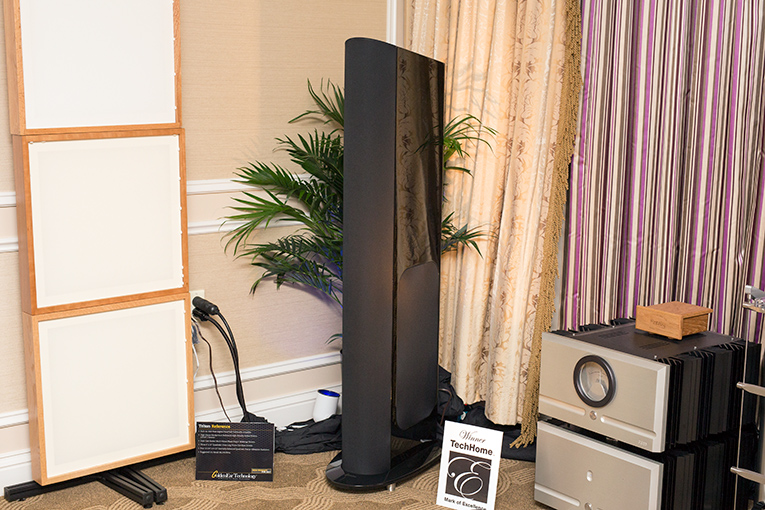
Well, at CES 2017 Gross surprised us with a new Triton flagship, and has found a way around the naming problem by calling it the Triton Reference ($8448/pair). So . . . two years ago, was he pulling our legs? When I asked him, he told me that while the Triton One was supposed to be the flagship, following its launch they discovered that they had customers willing to pay still more for a GoldenEar speaker that could go even lower in the bass, was cleaner throughout the audioband, and would provide higher output overall. Those people were also willing to pay for a speaker that looked a bit nicer than the Triton One.
The Triton Reference is the same shape as the other Triton models, but its cabinet is about 20% larger than the One’s. Instead of matte-black grille cloth all around, like the other Tritons, its left and right side panels and curved rear panel are of wood finished in high-gloss black. It’s definitely the sharpest-looking Triton ever.
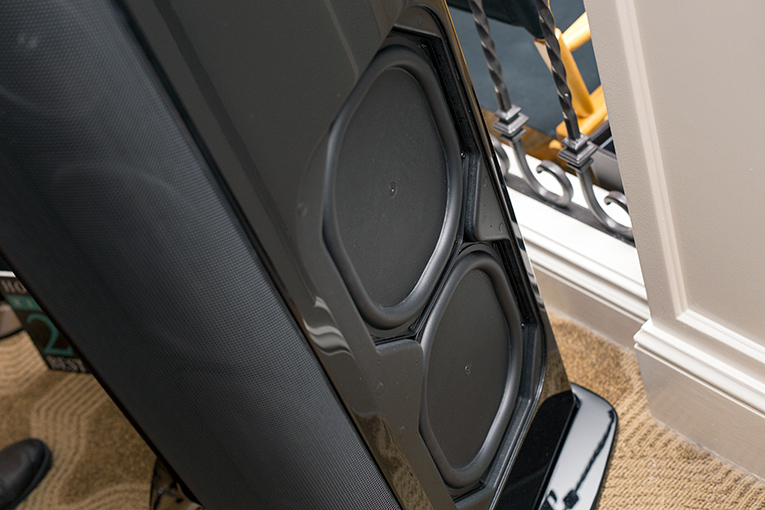
For better sound, the Reference has all new drivers. In addition, the woofers are driven by a higher-powered built-in amplifier with better DSP processing than in the other models, including the One, to reach lower and play louder. While the two new midrange drivers are claimed to provide lower distortion than their counterparts in other Triton models, what I’m most interested in is GoldenEar’s new HVFR tweeter, which, they say, needs much less power than did the One’s tweeter to produce the same output level. This will mean less buildup of heat within the tweeter and, in turn, lower levels of compression. When I reviewed the Triton One, I found it offered incredible sound quality for $4999.98/pair; if the Triton Reference substantially improves on that performance, particularly in regard to overall output capability, GoldenEar will have upped the ante for what we can and should expect from a full-range, floorstanding speaker costing less than $10,000/pair. I heard the prototypes in Vegas, and the promise of better sound was apparent. Suffice it to say that Sandy Gross’s surprise was a good one -- I’m excited to find out what the production models of the Triton Reference sound like when they start rolling off the assembly line toward the middle of this year.
Arcam rPhono phono stage
Lately, I’ve had a hankering to have a high-quality, high-value, feature-rich phono stage in my listening room, but not much of what I’d seen on the market had impressed me -- until, at CES 2017, I saw Arcam’s new rPhono. There were several reasons for this. First, the features, including adjustable input impedance, capacitance, and gain -- the rPhono should be usable with just about any cartridge. There’s also a rumble filter, to get rid of low-frequency nasties (though I rarely need such a thing). Then there’s the parts quality, which seems high, with a strong focus on what matters most: outstanding RIAA frequency response, aka high accuracy. And, of course, there’s the reasonable price: $600.
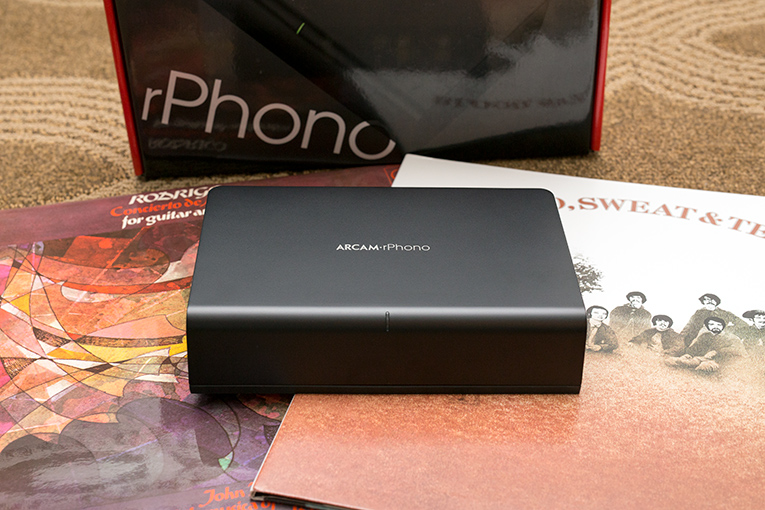
But even all that might not have impressed me as much as knowing who’s behind the rPhono’s design: Arcam cofounder John Dawson. It was Dawson himself who demonstrated the rPhono to me at CES 2017, and he was clearly proud of what he’d accomplished. Dawson started Arcam on the principle of providing exceptionally well-designed hi-fi gear for very reasonable prices, and I can personally attest that he’s succeeded -- in the past, I’ve found that Arcam’s integrated amplifiers and CD players offer such great sound quality that they make me wonder if it makes sense to spend more. Over the years, some of our other writers, such as Hans Wetzel and Roger Kanno, have come to the same conclusion, particularly about Arcam’s DACs. In fact, we have yet to encounter a clunker from this highly reputable British brand. If the rPhono carries on that tradition -- I see no reason why it shouldn’t -- then it will sonically compete with far pricier products. Which will make it just the phono stage I’ve been looking for. Here’s hoping we get one for review soon.
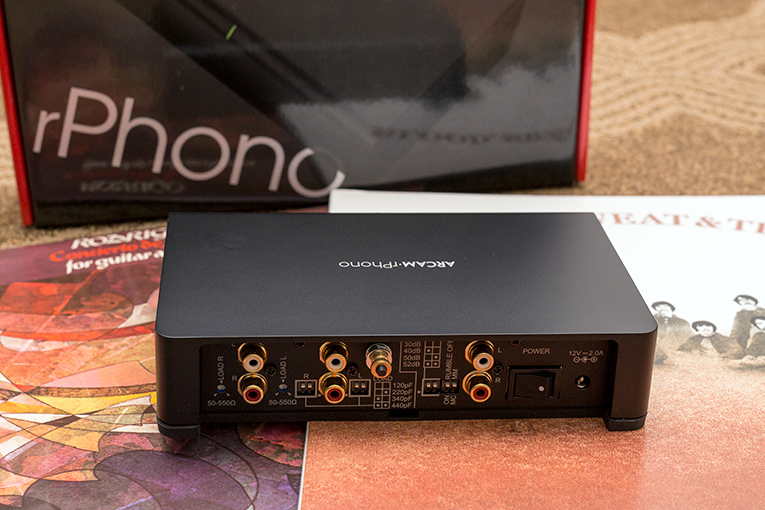
Simaudio Moon Evolution 888 mono power amplifier
The first product I discuss in this column was one of the most expensive speaker systems displayed at CES 2017; the last is one of the most expensive amps: Simaudio’s Moon Evolution 888 mono amplifier ($118,888/pair). One of these monoblocks measures 22”W x 14”H x 27”D and weighs almost 300 pounds. Commensurate with its size and weight are the 888’s prodigious power-output capabilities: 888W into 8 ohms or 1776W into 4 ohms, with the ability to competently drive even more difficult loads. (Protection circuitry will kick in before you can let it drive a short circuit -- just so you know.)
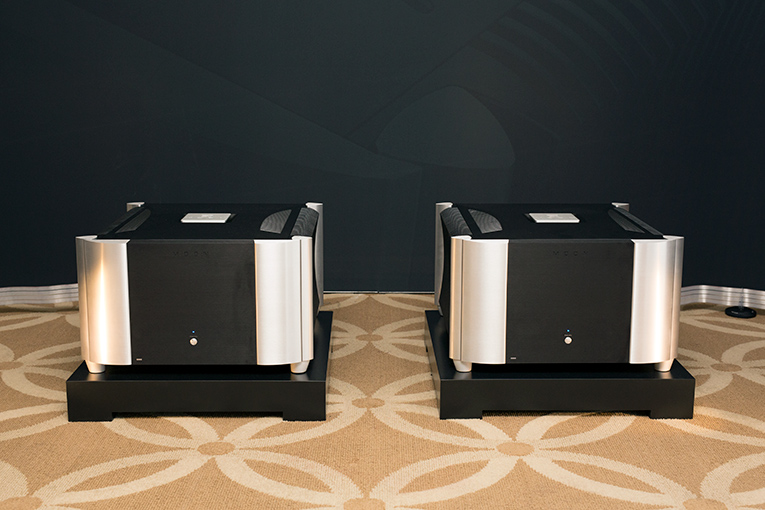
Those who believe that, in amps, bigger is always better might be attracted by the 888’s sheer size and weight and power delivery. But I know Simaudio’s reputation well, having used and reviewed many of their products over the years, and their Dominique Poupart told me two things about the Moon Evolution 888 that made my ears prick up. First, he believes that it’s the first amplifier they’ve produced that fully reveals just how good Simaudio’s preamps are -- particularly their statement model, the Moon Evolution 850P ($30,000). I haven’t heard the 850P, but I’ve used their Moon Evolution 740P ($9500) for a couple years, with and without the optional Moon Evolution 820S external power supply ($8000), and I can attest to how transparent to recordings it is -- as if it’s not even there, even without the 820S supply. If the 850P is only a little more transparent, then wow -- color me impressed in advance. It’s hard to imagine that anything could be better than the 740P. And if the Moon Evolution 888 has been designed to be on a par with that level of performance . . . well, I’m all ears, no matter how much it costs.
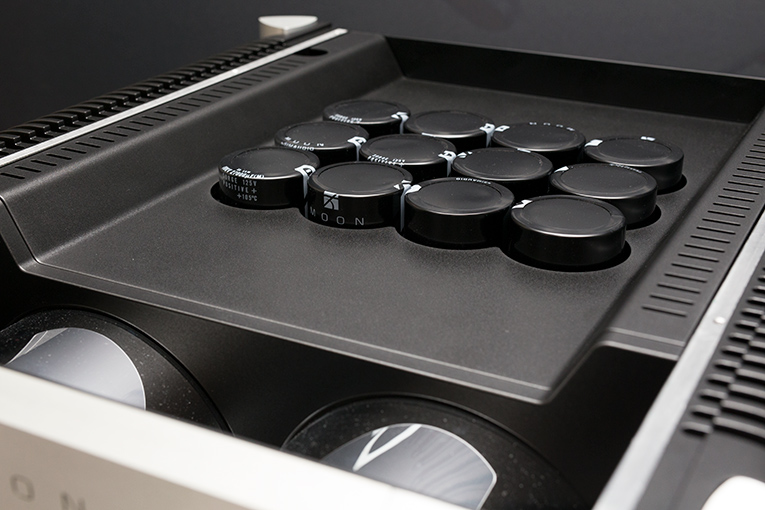
The other thing Poupart told me was that when the Simaudio design team was assigned the 888 project, they were given no limits, in terms of cost or other practical considerations -- they could create whatever they wanted. What they’ve created in the Moon Evolution 888 looks glorious, with nice touches that go beyond sheer power output and other things that affect sound quality. When Poupart lifted the 888’s hood, all I saw was a “subcover” that reveals only the tops of the capacitors and the chromed transformers. The 888’s guts are fully revealed only when this subcover is removed. When Poupart did that, it became obvious that Simaudio really has gone all out in the making of this amp.
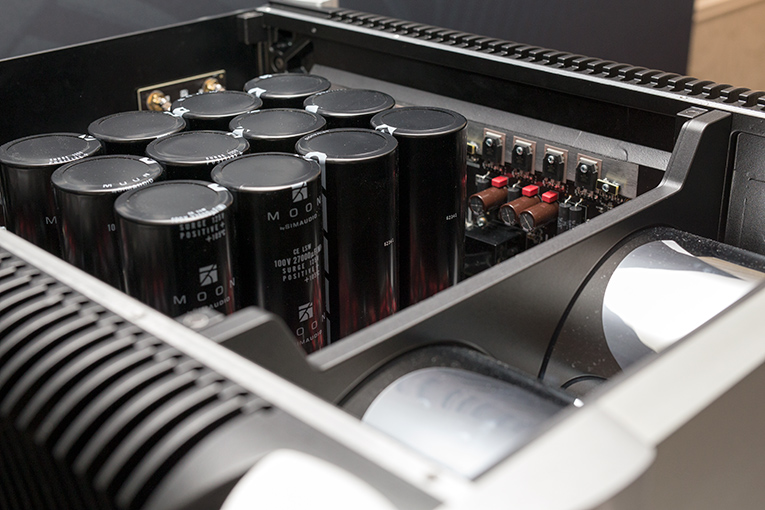
My selection of Simaudio’s Moon Evolution 888 and YGA’s Sonja XV speaker system as two of the Best of CES 2017 might be surprising -- after all, I’m usually a champion of high-value affordable gear. But I’m happy to see Simaudio get so ambitious, and what they’ve learned from designing and building the 888 will no doubt eventually trickle down into less-expensive amplifiers that more of us can afford. Kudos to this well-known Canadian brand for showing us all they can do.
Next year?
Following the hi-fi failure that was the 2017 Consumer Electronics Show, many attendees were asking if there will even be a high-end section at CES 2018. As far as I can tell, there will -- but unless someone does something drastic to improve the situation in Las Vegas, it’s going to get even worse -- and that means it will be really bad. With that in mind, we’ve decided that, unless something changes, we won’t be there, because we feel there’s little value for us or our readers.
That doesn’t mean we’re reducing our coverage of audio shows. As it stands, we provide more than any other publication in the world, and we plan to do even more. High End (Munich), Salon Audio (Montreal, formerly Salon Son & Image), TIAS (Tokyo), and Audio Video Show (Warsaw) are regular stops for us, and have already been penciled into our travel agendas. These are all great, well-established shows that aren’t going anywhere, and for some of them we’ll probably even increase the number of reporters we send. And there are other shows that are growing and that we’re now considering covering -- we’ll let you know when we make our decisions. Our annual jaunt to Las Vegas to cover CES may be coming to an end, but we see this as an opportunity to change, expand, and improve our coverage of other audio shows, to benefit our readers even more.
. . . Doug Schneider
das@soundstagenetwork.com






















